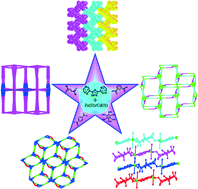Five novel Zn(ii)/Cd(ii) coordination polymers based on bis(pyrazinyl)-triazole and varied polycarboxylates: syntheses, topologies and photoluminescence†
Abstract
Five novel Zn(II)/Cd(II) coordination polymers (CPs) based on the V-shaped ligand 1H-3,5-bis(pyrazinyl)-1,2,4-triazole (Hbpt) and different polycarboxylates, {[Cd(bpt)(H2O)]·ClO4·H2O} (1), {[Cd4(bpt)2(suc)2.5(OH)]·3H2O} (2), {[Cd4(bpt)3(1,3-bdc)2.5]·4H2O} (3), {[Cd9(bpt)6(1,4-bdc)6(H2O)2]·4H2O} (4) and {[Zn2(bpt)(H3bhc)(H2O)6]·H2O} (5) (H2suc = succinic acid, 1,3-H2bdc = isophthalic acid, 1,4-H2bdc = terephthalic acid, H6bhc = benzene-1,2,3,4,5,6-hexacarboxylic acid), have been successfully synthesized. Their structures have been characterized using single-crystal X-ray crystallography, powder X-ray diffraction (PXRD) analyses, elemental analyses, IR spectroscopy, and thermogravimetric analyses (TGA). Complex 1 bears a two-dimensional (2D) layered (3,3) network, which is further extended into the resulting three-dimensional (3D) supramolecular architecture via π⋯π stacking interactions between the terminal pyrazine groups of bpt− ligands. In 2, Cd(II) ions and bpt− ligands construct a 2D Cd-bpt layer and two 1D zigzag chains, which are further connected by suc2− ligands to form a 2D + 1D → 3D (4,5)-connected framework. Complex 3 contains two kinds of grids, and their alternating arrangement gives a final complicated 3,4,5-connected network with a stoichiometry of (3-c)6(4-c)9(5-c)2. In 4, the bpt− ligands act as tetradentate ones to connect neighbouring Cd(II) ions into an infinite 1D Cd-bpt chain. The completely deprotonated 1,4-bdc2− ligands further link the adjacent Cd-bpt chains to generate a novel 3,4,6-connected 3D topological network with (3-c)2(4-c)14(6-c). Complex 5 displays an infinite 1D coordination chain. There are strong π⋯π stacking interactions between adjacent chains in 5 with a centroid–centroid distance of 3.860 Å and 3.862 Å, resulting in a 3D supramolecular structure. The results show that Hbpt can act as a versatile building block for the construction of various coordination polymers. Moreover, the fluorescence properties of 1–5 in the solid state have also been investigated.


 Please wait while we load your content...
Please wait while we load your content...